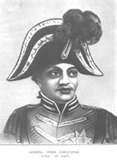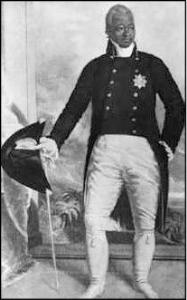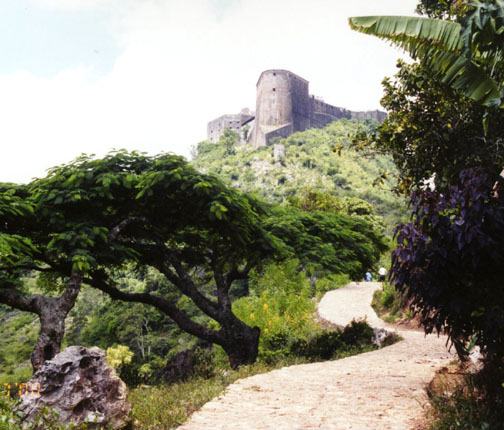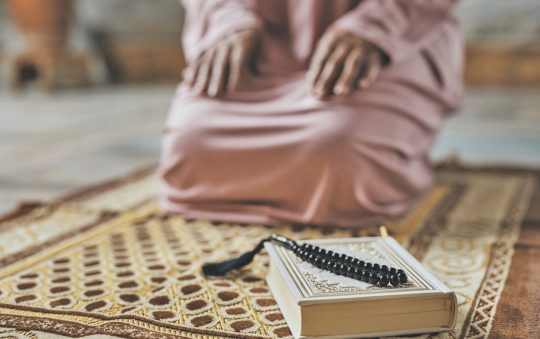
General Henri Christophe

King Christophe

The Citadel

In Memory of the King
Legends
By Yussuf J. Simmonds
HENRI CHRISTOPHE
“One of the architects of the Haitian Revolution”
Henri Christophe (pronounced “Or-ree/Ah-ree Kris-tof”), whose date and place of birth have not been historically established to a certainty, played a prominent role in the war against the French during the Haitian Revolution and eventually rose to become the leader of Haiti. He was one of the triumvirates–along with Toussaint L’Ouverture and Jean Jacques Dessalines–that led to the independence of Haiti at the beginning of the 19th century.
The achievements of many historical figures attract movie-makers who chronicle their lives on film, and during the 1960s stage/screen actor, William Marshall, contemplated making a movie about Christophe. He had played a fictional character, King Dick, loosely based on Christophe in his first screen role in 1952. The introduction to the proposed movie, King Christophe of Haiti, was as follows:
“Henri Christophe (1767-1820) was one of the three Black generals who led Haiti’s slave revolution and defended it successfully in a War of Independence against the armies of Napoleon. Christophe made Haiti a kingdom and himself king as one further step in his single-minded dedication to establishing a secure and prosperous modern Black nation that would command the respect of the nations of the world. In the last years of his reign, he channeled Haitian energies on a massive scale into building an impregnable mountain fortress, the Citadel, one of the architectural wonders of the world. It still stands today–a great stone prow thrusting through the clouds 2,000 feet above the foothills, with walls 20 feet thick and 130 feet high, dominating all approaches. Built as an ultimate bastion against those who would seek to enslave Black people again, it endures as a monument to Black resolution and aspiration.”
In addition to Christophe’s military exploits, the Citadelle LaferriÂre (the Citadel) is remembered as one of his lasting achievements and has become an icon of Haiti. Located in Northern Haiti, south of Cap-Haitien, it is the largest fortress in the Americas and was designated by the United Nations Educational, Scientific and Cultural Organization (UNESCO) as a World Heritage Site in 1982. The fortress was capable of accommodating 10,000 soldiers; it had a self-contained underground cistern that provided water via collected rain water. Based on Haiti’s experience with the French–their deceit and treachery–it was Christophe’s plan that in the event of another French attack and/or invasion, his forces would burn everything along the coast and retreat to the Citadel, setting ambushes along the road leading to the fortress.
Within the Citadel, there were fortifications including two forts overlooking the capital that had been built by Dessalines for the same purpose and whom it was believed was destroyed through the machination of Christophe and Alexandre Petion. They had joined Dessalines together and were instrumental in his eventual success against the French. But after they conspired to get rid of Dessalines, they too had a power struggle which ended up with a divided country: Christophe ruling the North as president, and Petion, the South.
According to historical records and stories passed down by the griots in Haiti, Christophe was born around October 6, 1767 in Grenada and brought to Haiti (then Saint Domingue) as a slave. Prior to becoming oriented to military service, Christophe worked as a mason, a stable hand, and a waiter at an inn. He was later bought by the master who operated the inn, where he became skilful at dealing with the wealthy White French plantation owners. He joined the Slave Revolt of 1791 and distinguished himself that he quickly rose to be an officer. For years, Christophe fought under Toussaint’s leadership in the northern section of Haiti.
By 1802, the French had been defeated and Christophe had been promoted to the rank of General; Toussaint was governor-general and Dessalines was governor of the province. Less than a year later, the French sent troops again to re-capture the island; it was Christophe they first encountered. Without Toussaint’s approval, Christophe, based on previous experience, did not welcome the French. So, they attacked, and not having the peasants’ support, Christophe had to retreat. But after learning that the French returned the plantations to their former slave-master owners and wanted to reinstitute slavery, the peasants rushed to join Christophe.
Meanwhile, Toussaint was tricked by the French, captured and taken to France where he eventually died in a French prison. Dessalines then came to power, and he and General Christophe had an uneasy relationship under Dessalines’ leadership, particularly after Dessalines proclaimed himself “Emperor.” Along with Petion, Christophe bided the time waiting for an opportunity to seize power from Dessalines. The opportunity came in 1806; and after Dessalines was assassinated, Christophe seized the reins of power–though his power was concentrated in the North (of Haiti).
Shades of blackness became evident in the power struggle that ensued between Christophe (who was a dark-skinned Black) and Petion (who was a light-skinned Black or mulatto, a “gens de couleur,”–people of color). The only time the dark-skinned Blacks and the mulattos formed an alliance was to battle the French, whom they regarded as their common enemy. Christophe was not an educated man so he had to employ “gens of couleur” in his administration because many of them were educated, and he needed the benefit of their knowledge to run the country. The country (northern Haiti) he inherited was in a war-torn state disarrayed and the bulk of his people were floundering ex-slaves. His base of operations was the Plaine du Nord where he administered a separate government, and initially declared president, and general of the armies of land and sea of the State of Haiti–much like the president and commander-in-chief of the U.S., from where he patterned the concept.
He entered trade agreements with the U.S. and Britain, and resisted commerce trading with France and Spain, against whose forces he had fought during the Haitian Revolution … and even after Haiti had declared its independence. The country’s medium of exchange was the green gourd; in 1807, it was replaced by the metal coin, called the gourde, which became the monetary unit of Haiti. (It is another one of the lasting legacies of the revolution; today, it is still Haiti’s principal monetary unit).
Though Toussaint and Dessalines were gone, Christophe continued their thrusts toward the development of the island’s natural resources and foreign trade. From Toussaint he had learned that Haiti’s fight was more against the evils of slavery as an institution–and any nation that promoted and sustained it–and forced it on the African people in general and the Haitian people in particular … be they European/British or American.
Creating a system of labor to increase agricultural production was a tough call for Christophe since any large scale undertaking of plantation work at that time had the “odor” of slavery by another name. In addition to developing a plantation system fueled by labor or parceling out the land for cultivation that previously was the scourge of Haiti’s problems, Christophe had to be careful not to be seen as “re-instituting” slavery or the “new and improved, Black” slave-master.
Within the first year Haiti prospered under Christophe’s leadership. The fields glistened with an abundance of crops and the young nation earned the name the “Pearl of the Antilles,” as it produced and exported millions of pounds of sugar, coffee and cotton. Those goods were traded/exchanged with foreign powers–including European colonies in the West Indies–for gold and enormous sums of money for the Haitian treasury, which helped stabilized its economy despite non-recognition policies of France and Spain. Both countries did not recognize Haiti as an independent country and worked assiduously to implore other countries to follow suit economically and diplomatically. (Later on, they succeeded and that policy has resulted in devastation of Haiti up to the present). Christophe even made an agreement with Britain that Haiti would not be a threat to their Caribbean colonies in return for a hands-off British policy against the island; a promise that Britain would warn Haiti of any imminent attack from French troops; and abolishing the importation of African slaves to British colonies in the West Indies.
Christophe learned about other world leaders and incorporated some of their leadership policies into his own beliefs. One such belief was that Haiti would gain more respect if it had a king, so he had himself declared King Christophe of Haiti in April 1811, ordained by the country’s archbishop. Then he believed that by creating a Haitian lineage of nobility, and having several palaces built for himself and his family would add authenticity to the rank and title of nobility. Christophe named one of his palaces Sans Souci after one belonging to Frederick the Great, King of Prussia, his idol, and from whom he modeled many of his “regal” policies. He had it decorated with lavish furnishings and art treasures from around the world.
He made his son, Jacques Victoire Henry, heir apparent and future “king” of Haiti with the title of Prince Royal of Haiti, and another son, a colonel in the Haitian military. Cap FranÂais became Cap-Henri. (It was later on renamed Cap-Ha•tien). Christophe wanted to establish life in Haiti to revolve around him as the king and absolute ruler with the people as his subjects, based on a feudal system. He called the legal system Code Henri but was not as successful in establishing a Henri education system, though he placed great importance on education.
Gradually, Christophe became unpopular and disliked. Outwardly, all the signs showcased the pomp and majesty of success but there were internal signs of strife, resentment and dissatisfaction. In addition, (Petion’s) South Haiti did not enjoy the same level of prosperity as (Christophe’s) North, and that also created major challenges and envy. Since the South was ruled by “gens de couleur,” the educated class, the challenges and envy became obvious. Christophe’s drive to maintain economic production began to spur further resentment especially as he began to institute penalties …. that got harsher and more severe when production did not meet his expectations.
As the King became more autocratic and seemingly motivated by personal gain and ambition, he alienated himself from the people, and a coup seemed inevitable. In 1820, Christophe suffered a stroke and was paralyzed. On hearing the news, his soldiers no longer felt allegiance to their commander and many islanders rejoiced. Rather than face the inevitability of a coup, Christophe shot himself with a silver bullet. He was buried in the Citadel.
LEGACY
Prior to Christophe’ death, his son was assassinated and that supposedly ended his “royal” lineage. However, his grandson, Pierre Nord Alexis, became the President of Haiti from 1902-1908; and his great, great, great granddaughter, MichÂle Bennett Duvalier, was the First Lady of Haiti from 1980 to 1986.
It is instructive to note the historic and lasting impact that the Haitian Revolution had on those countries that prospered, and benefited from slavery. In his book, IN THE MATTER OF COLOR Race & the American Legal Process: the Colonial Period, Judge A. Leon Higginbotham, Jr. wrote: “Besides fearing for the economic stability of the islands, (British) Parliament also had before it the specter of Haiti, which was established as an independent nation in 1804 after a violent slave revolt against the French. Undoubtedly, the West Indian planters were eager to limit the Black population in the islands in order to limit the successful prospects of any future slave revolts.”
Â






